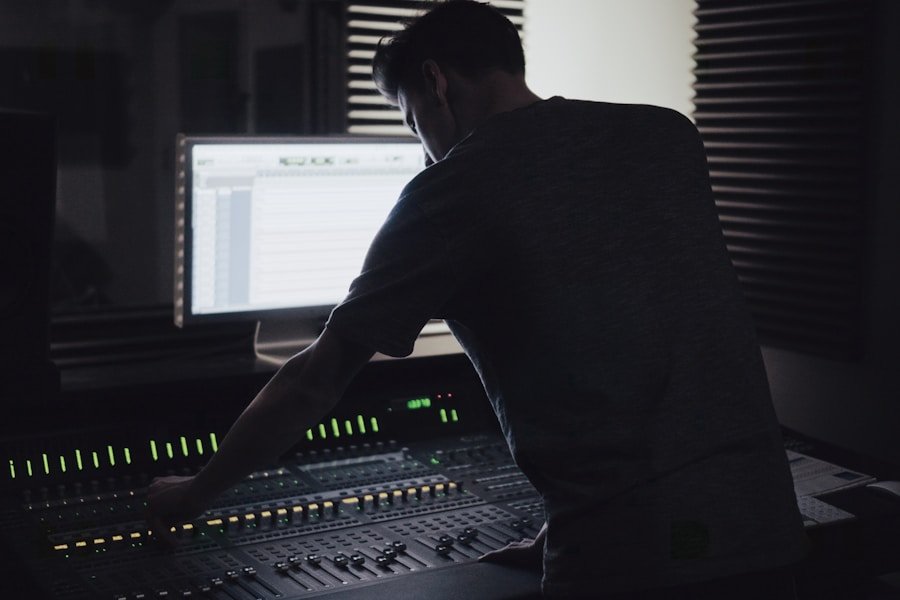Now Reading: Why Great Sound Design Is a Game-Changer
-
01
Why Great Sound Design Is a Game-Changer
Why Great Sound Design Is a Game-Changer

When I think about the immersive experiences in gaming, sound design often stands out as a crucial element that can make or break the overall atmosphere. The auditory landscape of a game envelops me, drawing me deeper into its world. From the subtle rustle of leaves in a forest to the thunderous roar of a dragon, sound design creates a rich tapestry that enhances my sense of presence.
It’s not just about what I see on the screen; it’s about what I hear that truly transports me into another realm. The careful crafting of sound effects, ambient noises, and musical scores can transform a simple gaming session into an unforgettable journey. Moreover, sound design plays a pivotal role in how I perceive the environment and the narrative unfolding before me.
When I hear the distant echo of footsteps or the chilling howl of the wind, I can almost feel the tension building around me. These auditory cues serve as a bridge between my reality and the game world, allowing me to lose myself in the experience. The meticulous attention to detail in sound design can evoke memories and emotions, making me feel as if I am part of the story rather than just an observer.
This level of immersion is what keeps me coming back for more, eager to explore every nook and cranny of the virtual landscapes.
Key Takeaways
- Sound design plays a crucial role in immersing players in the gaming experience, enhancing their sense of presence and engagement.
- By utilizing sound to evoke emotions and create a deeper connection with the game world, developers can enhance the overall gaming experience for players.
- Sound design serves as a powerful tool for storytelling, helping to convey narrative elements and guide players through the game’s plot and world.
- A unique audio identity can make a game more memorable and distinguish it from others, leaving a lasting impression on players.
- Effective sound design can improve gameplay and user experience by providing important auditory cues and feedback, enhancing player performance and enjoyment.
Enhancing Emotional Connection Through Sound
Sound design is not merely a backdrop; it is a powerful tool that enhances my emotional connection to the characters and narratives within a game. The music swells at pivotal moments, heightening my feelings of joy, sorrow, or tension. For instance, when a character faces a significant loss, the somber notes resonate with my own experiences, allowing me to empathize deeply with their plight.
This emotional resonance is often achieved through carefully selected musical scores that complement the visual storytelling, creating a holistic experience that lingers long after I’ve put down the controller. Additionally, sound effects can evoke visceral reactions that words alone cannot convey. The crackling of fire, the clashing of swords, or even the soft whispers of characters can elicit feelings of excitement or dread.
These auditory elements help to build a connection between me and the game’s narrative, making me feel invested in the outcomes of the characters’ journeys. When I hear a familiar theme associated with a beloved character, it brings back memories of my adventures together, reinforcing my bond with them. This emotional connection is what transforms gaming from a mere pastime into a profound experience that resonates on multiple levels.
Sound Design as a Tool for Storytelling

In my experience, sound design serves as an essential narrative device that enriches storytelling in games. It provides context and depth to the plot, often conveying information that visuals alone cannot express. For example, when I hear ominous music playing in the background, I instinctively know that danger is lurking nearby, even before I see it on screen.
This auditory foreshadowing enhances my understanding of the story and keeps me engaged as I navigate through various challenges. Furthermore, sound design can also reveal character traits and motivations without uttering a single word. The way a character’s footsteps sound—heavy and deliberate versus light and hurried—can tell me volumes about their state of mind or intentions.
Subtle audio cues can indicate shifts in mood or tension, guiding my emotional response to the unfolding narrative. This intricate interplay between sound and story allows me to experience the game on a deeper level, as I become attuned to the nuances that shape the characters’ journeys.
Creating a Memorable and Unique Audio Identity
Every game has its own unique audio identity that sets it apart from others, and this is something I find particularly fascinating. The distinct sounds associated with a game can become iconic, creating lasting impressions that resonate with players long after they’ve finished playing. For instance, when I hear the unmistakable chime of coins from a classic platformer or the haunting melody from an epic RPG, it instantly transports me back to those moments spent immersed in those worlds.
Developers often invest significant time and resources into crafting these unique audio identities because they understand their importance in branding and recognition. A well-designed audio logo or theme can evoke nostalgia and familiarity, making me more likely to engage with sequels or spin-offs. This auditory branding not only enhances my gaming experience but also fosters a sense of community among players who share similar memories tied to those sounds.
In this way, sound design becomes an integral part of a game’s legacy, contributing to its overall impact on popular culture.
Improving Gameplay and User Experience
Sound design is not just about creating an atmosphere; it also plays a vital role in improving gameplay mechanics and user experience. As I navigate through various challenges in a game, audio cues often provide essential feedback that informs my actions. For example, when I hear the satisfying sound of a successful hit or the warning beep indicating low health, it prompts me to adjust my strategy accordingly.
These auditory signals enhance my ability to respond quickly and effectively to in-game situations. Moreover, sound design can also guide me through complex environments by providing directional cues. The subtle shift in volume or panning can indicate where enemies are lurking or where objectives are located.
This intuitive use of sound allows me to immerse myself fully in gameplay without feeling overwhelmed by visual clutter. By enhancing my awareness of my surroundings through audio feedback, sound design ultimately contributes to a more enjoyable and engaging gaming experience.
Sound Design’s Influence on Player Engagement

The influence of sound design on player engagement cannot be overstated. As I delve into different gaming experiences, I often find that well-executed audio elements keep me hooked for longer periods. The combination of immersive soundscapes and compelling narratives creates an environment where I feel compelled to explore every corner of the game world.
When I hear captivating music or intriguing sound effects, it piques my curiosity and encourages me to continue my journey. Additionally, sound design can foster social interactions among players. In multiplayer games, for instance, voice chat and team-based audio cues enhance communication and collaboration.
The ability to strategize with teammates through clear audio channels elevates the overall experience and strengthens bonds within gaming communities. This social aspect of sound design not only enhances engagement but also creates lasting memories shared among players as they navigate challenges together.
The Role of Sound Design in Setting the Tone and Atmosphere
Sound design is instrumental in establishing the tone and atmosphere of a game from the very beginning. As soon as I launch a new title, the opening music sets expectations for what lies ahead—whether it’s an epic adventure filled with heroism or a chilling horror experience that sends shivers down my spine. The initial auditory cues create an emotional framework that influences how I perceive the entire game.
Throughout my gameplay experience, sound design continues to shape the atmosphere by adapting to different scenarios. For instance, during tense moments, the music may become more frenetic, while quieter scenes may feature soft melodies or ambient sounds that evoke introspection. This dynamic interplay between sound and visuals creates an immersive environment where I can fully engage with the narrative and characters.
By skillfully manipulating audio elements, developers can craft experiences that resonate deeply with players like myself.
The Future of Sound Design in Gaming
As technology continues to evolve, so too does the potential for sound design in gaming. With advancements in spatial audio and virtual reality, I am excited about how these innovations will further enhance immersion and engagement in future titles. Imagine being able to pinpoint sounds with incredible accuracy in a 3D space or experiencing music that adapts dynamically based on my actions within the game world—these possibilities are thrilling.
Moreover, as developers increasingly recognize the importance of inclusivity in gaming experiences, I anticipate that sound design will play a crucial role in making games accessible to all players. By incorporating features such as customizable audio settings or descriptive audio for visually impaired gamers, developers can ensure that everyone has an opportunity to enjoy rich auditory experiences. As we move forward into this new era of gaming, I am eager to see how sound design will continue to shape our interactions with virtual worlds and deepen our connections to stories yet untold.
Great sound design is crucial in creating an immersive gaming experience, as discussed in the article “Why Great Sound Design Is a Game-Changer.” Sound plays a significant role in enhancing gameplay and creating a more engaging environment for players. For those looking to dive into the world of esports, this article offers valuable tips and insights on how to master the art of mobile game streaming.
FAQs
What is sound design?
Sound design is the process of creating and manipulating audio elements to enhance the overall experience of a film, video game, or other multimedia project. It involves the use of sound effects, music, dialogue, and other audio components to create a specific atmosphere and convey emotions.
Why is great sound design important?
Great sound design is important because it can significantly enhance the overall impact and immersion of a multimedia project. It can help to create a more engaging and realistic experience for the audience, and can also convey emotions, set the tone, and guide the narrative of the project.
How does sound design impact video games?
In video games, sound design plays a crucial role in creating a more immersive and interactive experience for players. It can help to establish the game world, provide important auditory cues, and enhance the overall atmosphere and mood of the game.
What are some examples of great sound design in film?
Some examples of great sound design in film include the use of sound effects and music in creating tension and suspense in horror movies, the use of realistic and immersive soundscapes in nature documentaries, and the use of sound to convey emotions and enhance storytelling in dramas.
How does sound design contribute to storytelling?
Sound design contributes to storytelling by helping to establish the mood and atmosphere of a scene, conveying emotions, guiding the narrative, and providing important auditory cues to the audience. It can help to create a more immersive and engaging experience for the audience, and can enhance the overall impact of the story.



























